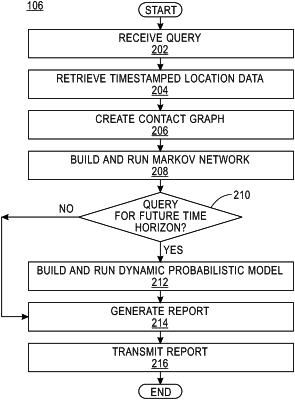| CPC G16H 50/80 (2018.01) [G06F 16/9024 (2019.01); G06F 17/18 (2013.01); G16H 15/00 (2018.01)] | 20 Claims |

|
1. A computer-implemented method comprising:
receiving, by one or more computer processors, a query associated with contact tracing of a person with an infection, wherein the query included a future time horizon;
retrieving, by one or more computer processors, timestamped location data associated with the person over a period of time;
based on the retrieved timestamped location data, creating, by one or more computer processors, a contact graph associated with the person;
retrieving, by one or more computer processors, medical data associated with the person and the one or more other people that were in contact with the person over the period of time;
based on the contact graph and on the retrieved medical data, building, by one or more processors, a probabilistic model;
dividing, by one or more computer processors, the future time horizon into a set of equal subsets;
capturing, by one or more computer processors, one or more dependencies between the person and the one or more other people depicted in the contact graph within each subset of the set of equal subsets of the future time horizon using the probabilistic model;
based on a learned transition probability distribution for each of the one or more other people depicted in the contact graph for each subset of the set of subsets of the future time horizon, creating, by one or more computer processors, a unique graphical probabilistic model for each subset of the set of subsets of the future time horizon;
building, by one or more computer processors, a dynamic probabilistic model by stitching together the unique graphical probabilistic models for each subset of the set of subsets of the future time horizon for each of the one or more other people depicted in the contact graph; and
running, by one or more computer processors, the dynamic probabilistic model to provide the prediction of the probability of infection of the one or more other people over the future time horizon.
|